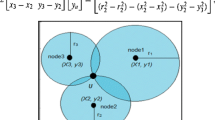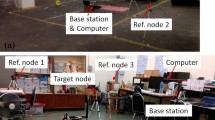Abstract
Localization has been a major research area in Wireless Sensor Networks \(\left( {WSN} \right)\) and has a rich literature of using many methods to estimate location accuracy. In \(WSN\), localization systems use data from sensors which receive signals from beacons. The information received from a sensor node provides data about the location in the sequence. So it must be accurately estimated in a networked transportation system since the movement of data in the system involves both time and space coordinates. To estimate the location of the unknown nodes, wused the Received Signal Strength Indicator (RSSI), available on all wireless sensor nodes. The algorithm has been deloped to reduce the effect of non-deterministic delays using site-specific empirical models to achieve good location accuracy. As a measure of the propagation time of packets to reduce synchronization error, all nodes are synchronized using Round Trip Time and provide an accurate estimation of the node in time scale. Also, this paper describes the signal intensity based Extended Kalman filter for tracking a dynamically moving object from the optimized value of \(RSSI\). Our method is compared with the existing methods and proved to be better under various circumstances of localization and tracking.
















Similar content being viewed by others
Availability of Aata and Material
The data that supports the findings of this study are available on request from the corresponding author. The data is not publicly available due to containing information that could compromise the privacy of research participants.
Code Availability
The code that supports the findings of this study are available on request from the corresponding author. The code is not publicly available due to containing information that could compromise the privacy of research participants.
References
de Oliveira, H. A., Nakamura, E. F., Loureiro, A. A., & Boukerche, A. (2007). Localization in time and space for sensor networks. In 21st international conference on Advanced Information Networking and Applications (AINA'07) (pp. 539–546). IEEE. https://doi.org/10.1109/AINA.2007.86
Zhao, L., & Qilian, L. (2007). Hop-distance estimation in wireless sensor networks with applications to resources allocation. EURASIP Journal on Wireless Communications and Networking, 1, 084256.
Wang, C., & Li, X. (2007). Sensor localization under limited measurement capabilities. Network, IEEE, 21(3), 16–23.
Liu, C., Wu, K., & He, T. (2004). Sensor localization with ring overlapping based on comparison of received signal strength indicator. In 2004 IEEE international conference on mobile ad-hoc and sensor systems (pp. 516–518). IEEE.
Helen, M., Latvala, J., Ikonen, H., & Niittylahti, J. (2001). Using calibration in RSSI-based location tracking system. In Proceedings of the 5th world multiconference on Circuits, Systems, Communications and Computers (CSCC20001)
Akyildiz, I. F., Weilian, S., Yogesh, S., & Erdal, C. (2002). A survey on sensor networks. Communications Magazine, IEEE, 40(8), 102–114.
Savvides, A., Han, C. C., & Strivastava, M. B. (2001). Dynamic fine-grained localization in ad-hoc networks of sensors. In Proceedings of the 7th annual international conference on Mobile computing and networking (pp. 166–179). ACM.
He, T., Huang, C., Blum, B. M., Stankovic, J. A., & Abdelzaher, T. (2003). Range-free localization schemes for large scale sensor networks. In Proceedings of the 9th annual international conference on mobile computing and networking (pp. 81–95). ACM.
Bulusu, N., Heidemann, J., & Estrin, D. (2000). GPS-less low-cost outdoor localization for very small devices. IEEE Personal Communications, 7(5), 28–34.
Doherty, L., Pister, K. S. J., & Ghaoui, L. E. (2001) Convex position estimation in wireless sensor networks. In INFOCOM 2001. Twentieth annual joint conference of the IEEE computer and communications societies. Proceedings. IEEE (Vol. 3, pp. 1655–63). IEEE.
Čapkun, S., Hamdi, M., & Hubaux, J. P. (2002). GPS-free positioning in mobile ad hoc networks. Cluster Computing, 5(2), 157–167.
Want, R., Hopper, A., Falcao, V., & Gibbons, J. (1992). The active badge location system. ACM Transactions on Information Systems (TOIS), 10(1), 91–102.
Whitehouse, K., & Culler, D. (2002). Calibration as a parameter estimation problem in sensor network. In Proceedings ACM Workshop on Sensor Networks and Applications, Atlanta, GA.
Zhou, G., Tian, H., Sudha, K., & Stankovic, J. A. (2004) Impact of radio irregularity on wireless sensor networks. In Proceedings of the 2nd international conference on mobile systems, applications, and services (pp. 125–38). ACM.
Elnahraway, E., Li, X., & Martin, R. P. (2004). The limits of localization using rss. In Proceedings of the 2nd international conference on Embedded networked sensor systems (pp. 283–284). ACM.
Niewiadomska-Szynkiewicz, E. (2012). Localization in wireless sensor networks: Classification and evaluation of techniques. International Journal of Applied Mathematics and Computer Science, 22, 281–297. https://doi.org/10.2478/v10006-012-0021-x ISSN (Print) 1641-876X.
Amutha, B., & Ponnavaikko, M. (2009, October). Locate: A hybrid localization scheme for wireless sensor networks. In 2009 IEEE Symposium on industrial electronics and applications (Vol. 1, pp. 295–300). IEEE.
Naeem, A., Javed, A. R., Rizwan, M., Abbas, S., Lin, J. C. W., & Gadekallu, T. R. (2021). DARE-SEP: A hybrid approach of distance aware residual energy-efficient SEP for WSN. IEEE Transactions on Green Communications and Networking, 5(2), 611–621.
Penchalaiah, N., Emmanuel, J. N., Kamal, S. S., & Ramana, K. (2021). IoT based automatic irrigation system using wireless sensor networks. In ICCCE 2020 (pp. 1255–1272). Springer, Singapore.
Numan, M., Subhan, F., Khan, W. Z., Hakak, S., Haider, S., Reddy, G. T., Jolfaei, A., & Alazab, M. (2020). A systematic review on clone node detection in static wireless sensor networks. IEEE Access, 8, 65450–65461.
Khan, T., Singh, K., Hasan, M. H., Ahmad, K., Reddy, G. T., Mohan, S., & Ahmadian, A. (2021). ETERS: A comprehensive energy aware trust-based efficient routing scheme for adversarial WSNs. Future Generation Computer Systems, 125, 921–943.
Jothikumar, C., Ramana, K., Chakravarthy, V. D., Singh, S., & Ra, I. H. (2021). An efficient routing approach to maximize the lifetime of iot-based wireless sensor networks in 5G and beyond. Mobile Information Systems, 2021.
Patel, H., Singh Rajput, D., Thippa Reddy, G., Iwendi, C., Kashif Bashir, A., & Jo, O. (2020). A review on classification of imbalanced data for wireless sensor networks. International Journal of Distributed Sensor Networks, 16(4), 1550147720916404.
Pagano, S., Peirani, S., & Valle, M. (2015). Indoor ranging and localisation algorithm based on received signal strength indicator using statistic parameters for wireless sensor networks. IET Wireless Sensor Systems, 5(5), 243–249. https://doi.org/10.1049/iet-wss.2014.0027 Print ISSN 2043-6386, Online ISSN 2043-6394.
Jin, R., Xu, H., Che, Z., He, Q., & Wang, L. (2015). Experimental evaluation of reducing ranging-error based on receive signal strength indication in wireless sensor networks. IET Wireless Sensor Systems, 5(5), 228–234. https://doi.org/10.1049/iet-wss.2013.0139
Pal, A. (2010). Localization algorithms in wireless sensor networks: Current approaches and future challenges. Network Protocols and Algorithms, 2(1), 45–73. ISSN 1943-3581.
Sivrikaya, F., & Yener, B. (2004). Time synchronization in sensor networks: A survey. IEEE Network, 18(4), 45–50.
Pathirana, P., Bulusu, N., Jha, S., & Savkin, A. (2005). Node localization using mobile robots in delay-tolerant sensor networks. IEEE Transaction on Mobile Computer, 4(4), 285–296.
Ssu, K.-F., Ou, C.-H., & Jiau, H. (2005). Localization with mobile, anchor points in wireless sensor networks. IEEE Transactions on Vehicular Technology, 54(3), 1187–1197.
Puneet, G., & Sarie, A. (2015). Localization in wireless sensor networks with ranging error. Intelligent Distributed Computing, Advances in Intelligent Systems and Computing, 321, 55–69.
Zhang, A., Ye, X., & Hu, H. (2012). Point in triangle testing based trilateration localization algorithm in wireless sensor networks. KSII Transactions on Internet and Information Systems (TIIS), 6(10), 2567–2586.
Li, C., Li, Y., Shen, Y., Liu, L., & Cao, Q. (2010). An optimization algorithm for wireless sensor networks localization using multiplier method. In 2010 3rd international joint conference on computational science and optimization (Vol. 2, pp. 337–341). Huangshan, Anhui, China. IEEE.
Motter, P., Allgayer, R. S., Müller, I., & de Freitas, E. P. (2011). Practical issues in wireless sensor network localization systems using received signal strength indication. In 2011 IEEE Sensors Applications Symposium (pp. 227–232). San Antonio, TX, USA. IEEE.
Zhang, B., & Yu, F. (2010). An event-triggered localization algorithm for mobile wireless sensor networks. In 2010 2nd international conference on future computer and communication (Vol. 1, pp. 250–253).
Benkic, K., Malajner, M., Planinsic, P., & Cucej, Z. (2008). Using RSSI value for distance estimation in wireless sensor networks based on ZigBee. In 2008 15th international conference on systems, signals and image processing (pp. 303–306).
Al Alawi, R. (2011). RSSI based location estimation in wireless sensors networks. In 2011 17th IEEE International Conference on Networks (ICON) (pp. 118–122). IEEE.
Bahl, P., & Padmanabhan, V. N. (2000). RADAR: An in-building RF-based user location and tracking system. In Proceedings IEEE INFOCOM 2000. Conference on computer communications. Nineteenth annual joint conference of the IEEE computer and communications societies (Vol. 2, pp. 775–784). IEEE.
Lindsey, Q., Lymberopoulos, D., & Savvides, A. (2006). An empirical analysis of radio signal strength variability in ieee 802.15. 4 networks using monopole antennas. ENALAB Technical Report 050501.
Harder, A., Song, L., & Wang, Y. (2005). Towards an indoor location system using RF signal strength in IEEE 802.11 networks. In International Conference on Information Technology: Coding and Computing (Vol. 2, pp. 228–233). IEEE.
Adewumi, O. G., Djouani, K., & Kurien, A. M. (2013). RSSI based indoor and outdoor distance estimation for localization in WSN. In 2013 IEEE international conference on Industrial technology (ICIT), Feb 25–28 (pp. 1534–1539). IEEE.
Karagiannis, M., Chatzigiannakis, I., & Rolim, J. (2012). Multilateration: methods for clustering intersection points for wireless sensor networks localization with distance estimation error. arXiv preprint arXiv:1203.3704.
Baccour, N., Koubâa, A., Mottola, L., Zuniga, M. A., Youssef, H., Boano, C. A., & Alves, M. (2012). Radio link quality estimation in wireless sensor networks: A survey. ACM Transactions on Sensor Networks, 8(4), 1–33.
Zhang, R., Song, Y., Chu, F., & Sheng, B. (2012). Study of wireless sensor networks routing metric for high reliable transmission. Journal of Networks, 7(12), 2044–2050.
Bachrach, J., & Taylor, C. (2005). Localization in sensor networks, In: Handbook of Sensor Networks. Wiley. https://doi.org/10.1002/047174414X.ch9.
Hightower, J., Roy, W., & Gaetano, B. (2000). SpotON: An indoor 3D location sensing technology based on RF signal strength. UW CSE 00-02-02, University of Washington, Department of Computer Science and Engineering, Seattle, WA 1.
Patwari, N., & Hero III, A. O. (2003). Using proximity and quantized RSS for sensor localization in wireless networks. In Proceedings of the 2nd ACM international conference on Wireless sensor networks and applications (pp. 20–29).
Yedavalli, K., Krishnamachari, B., Ravula, S., & Srinivasan, B. (2005). Ecolocation: A sequence based technique for RF localization in wireless sensor networks. In Proceedings of the 4th international symposium on information processing in sensor networks, (Vol. 38). IEEE Press.
Blumenthal, J., Reichenbach, F., & Timmermann, D. (2005). Position estimation in ad hoc wireless sensor networks with low complexity. In Joint 2nd workshop on positioning, navigation and communication (pp. 41–49).
Jiang, J. A., Zheng, X. Y., Chen, Y. F., Wang, C. H., Chen, P. T., Chuang, C. L., & Chen, C. P. (2013). A distributed RSS-based localization using a dynamic circle expanding mechanism. IEEE Sensors Journal, 13(10), 3754–3766.
Hyun-Chul, Y., Hong-Ju, K., Yu-Jong, K., Joon-Young, C. (2012). RTT estimation method in WSN. In 2012 international conference on information and computer networks (ICICN 2012) ipcsit, Vol. 27 (2012) © (2012) IACSIT Press, Singapore.
Römer, K., & Mattern, F. (2005). Towards a unified view on space and time in sensor networks. Computer Communications, 28(13), 1484–1497.
Funding
This research did not receive any specific grant from funding agencies in the public, commercial, or not-for-profit sectors.
Author information
Authors and Affiliations
Contributions
AB: Conceptualization, Methodology, Software, Visualization KR: Data curation, Writing—original draft, Data Analysis, Investigation. KN: Software, Validation, Editing. MR: Software, Validation, Editing. VCB: Supervision, Writing—review and editing. SK: Software, Validation, Editing.
Corresponding author
Ethics declarations
Conflicts of interest
The authors declare that they have no known competing financial interests or personal relationships that could have appeared to influence the work reported in this paper.
Additional information
Publisher's Note
Springer Nature remains neutral with regard to jurisdictional claims in published maps and institutional affiliations.
Rights and permissions
About this article
Cite this article
Balakrishnan, A., Ramana, K., Nanmaran, K. et al. RSSI Based Localization and Tracking in a Spatial Network System using Wireless Sensor Networks. Wireless Pers Commun 123, 879–915 (2022). https://doi.org/10.1007/s11277-021-09161-0
Accepted:
Published:
Issue Date:
DOI: https://doi.org/10.1007/s11277-021-09161-0




